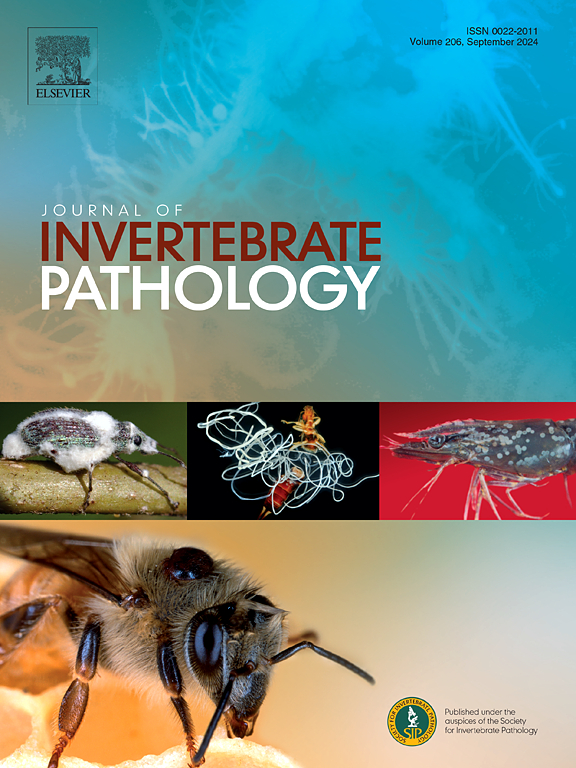Effects of Perkinsus olseni parasitism and environmental conditions on the gonad maturation and reproductive effort of female Manila clam (Ruditapes philippinarum) on the west and south coasts of Korea
IF 2.4
3区 生物学
Q1 ZOOLOGY
引用次数: 0
Abstract
In the intertidal zone, the reproductive dynamics of bivalves are influenced by both biotic and abiotic factors, including spatial and temporal fluctuations in sea surface temperature (SST), food availability, and diseases. Notably, disease proliferation is markedly enhanced under conditions favorable to pathogen entities, such as elevated SST and low food availability. This study examined the associative impacts of Perkinsus olseni parasites on the reproduction of the Manila clam Ruditapes philippinarum, across a latitudinal range covering four sampling sites along the west and south coasts of Korea, ranging approximately 400 km. In late June, we collected adult female clams to assess their condition index, reproductive output, and the prevalence of P. olseni infection. Histology indicated that 94 % of clams from SJ tidal flat, the cooler northwest coast were in the ripe stage. In contrast, clams from WD and GS, the warmer regions of the southwest and south exhibited more progressed stages of gonadal maturation, including the spent and resting phases. Notably, clams at the ripe stage in WD and GS demonstrated significantly lower gonad somatic index (GSI, P < 0.05) than their counterparts in the northwest. Moreover, the intensity of P. olseni infection was substantially higher (P < 0.05) in WD in the south compared to SJ in the northwest. The histopathological index (HPI) revealed minimal tissue damage and lower HPI scores at SJ, in stark contrast to the progressively severe tissue damage and elevated HPI scores observed moving southward along the latitudinal gradient. It was postulated that the combined effects of higher SST, low food availability, and high levels of P. olseni infection are key factors contributing to the reduced GSI and condition index (CI) in ripe clams in WD on the warm southern coast. Additionally, the lower CI observed in clams from WD potentially heightens their vulnerability to diseases by weakening their immune defenses during critical reproductive phases, such as spawning and post-spawning.

韩国西部和南部海岸马尼拉蛤雌虫寄生和环境条件对其性腺成熟和生殖力的影响
在潮间带,双壳类的繁殖动态受到生物和非生物因素的影响,包括海表温度(SST)的时空波动、食物供应和疾病。值得注意的是,在有利于病原体实体的条件下,如海温升高和食物供应不足,疾病增殖明显增强。本研究在韩国西部和南部海岸的四个采样点(约400公里)的纬度范围内考察了珀金苏斯(Perkinsus olseni)寄生虫对马尼拉蛤(Manila clam Ruditapes philippinarum)繁殖的相关影响。6月下旬,我们收集了成年雌蛤,评估了它们的状态指数、生殖产量和奥尔塞尼弧菌感染的流行情况。组织学研究表明,在较冷的西北沿海SJ潮滩,94%的蛤蜊处于成熟阶段。相比之下,来自WD和GS,西南部和南部温暖地区的蛤蜊表现出更多的性腺成熟阶段,包括消耗和休息阶段。值得注意的是,在成熟阶段,WD和GS的蛤性腺体细胞指数(GSI, P <;0.05),高于西北地区。此外,P. olseni感染的强度明显更高(P <;wd0.05),而SJ在西北偏大。组织病理学指数(HPI)显示SJ的组织损伤最小,HPI评分较低,与沿纬度梯度向南观察到的逐渐严重的组织损伤和升高的HPI评分形成鲜明对比。高海温、低食物可得性和高水平的P. olseni感染的综合作用是导致暖南海岸WD成熟蛤蜊GSI和状态指数(CI)降低的关键因素。此外,在WD蛤中观察到的较低CI可能会在关键的生殖阶段(如产卵和产卵后)削弱它们的免疫防御,从而增加它们对疾病的脆弱性。
本文章由计算机程序翻译,如有差异,请以英文原文为准。
求助全文
约1分钟内获得全文
求助全文
来源期刊
CiteScore
6.10
自引率
5.90%
发文量
94
审稿时长
1 months
期刊介绍:
The Journal of Invertebrate Pathology presents original research articles and notes on the induction and pathogenesis of diseases of invertebrates, including the suppression of diseases in beneficial species, and the use of diseases in controlling undesirable species. In addition, the journal publishes the results of physiological, morphological, genetic, immunological and ecological studies as related to the etiologic agents of diseases of invertebrates.
The Journal of Invertebrate Pathology is the adopted journal of the Society for Invertebrate Pathology, and is available to SIP members at a special reduced price.

 求助内容:
求助内容: 应助结果提醒方式:
应助结果提醒方式:


